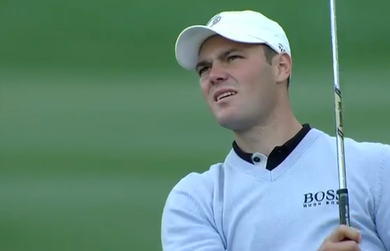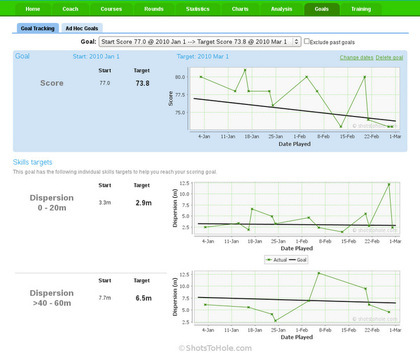 PGA and LPGA Tour professionals are the product of thousands of hours of practice and dedication to their craft. They are a rare breed of men and women who strive to play golf at the very edge of excellence. For many the task of competing many weeks of the year takes a heavy toll emotionally, physically and mentally because of the ever increasing standards they have to meet to remain competitive. There is a very fine line between good and great in professional golf and in today’s article I’m going to help to define just how close this line is. It might surprise you to know that the difference between a good professional golfer and a great one is just a stroke or two per round, but the key to this is not in understanding that the outcome is just one or two strokes per round but rather the skills within the score so to speak.  The Skills Within the Score At Pro Tour Golf College we often talk with our students about the ‘skills within the score’ and their influence on producing lower-more competitive golf scores in tournaments. The skills within the score are any golf skills that have an impact on improving your golf score average. Notice I said golf score average? What we’re talking about is a long term view of golf improvement that will push an already low score average lower which is precisely what elite amateur and professional golfers have to do. It’s not what you do from round to round that is as important as what you do from the information you obtain from 20 competitive rounds or more that will help you. You need a big picture look at your game to make decisions about the direction of your game. In our experience too many hasty decisions are made by elite golfers after a poor round or two, and this just isn’t enough information to make decisions that influence a lower golf score in the future. The skills within the score are sometimes hidden from view with a short term perspective and will only reveal themselves after producing enough data to extract the information from its hiding place. That is why it is important for you to compile enough rounds to really start to understand your weaknesses and then it will be easier to design an improvement strategy that influences a lower score average.  There Are Stat’s and then There Are Stat’s If you are a conscientious elite golfer you will ideally be already tracking all your golf performances with some type of golf statistics program of which there are many available on the internet. The starting point of generating change is to identify accurately where your game is currently and a statistics program can be very helpful. However when you get to a very low handicap or you know longer have one then basic statistics just won’t help you much at all. Hitting sixty percent of fairways doesn't tell you a whole lot about your tee-shots and where they went. Hitting 60 percent of greens in regulation doesn't tell us how far you hit your ball from the hole and where you hit your approach shots from, and 30 putts doesn't explain the distance you putted your putts from on each green. There’s just not enough information available with basic statistics to make better-more accurate predictions that will influence lower golf scores. The best way to really help your game is to use a program that can track every golf shot you hit on the golf course and then determine which of your golf skills is keeping your competitive golf score average higher than you would like. From the tee you want to know and be able to plot exactly where your golf ball went. With this information you can isolate particular trends within your shot-making that can help you and your golf coach/instructor to work with you on developing an appropriate strategy for improvement. I have spent a great deal of time looking at golf statistics programs (like I said there are many) that can help elite amateur golfers and professional golfers understand and quantify their results so they can bridge the performance gap and produce lower golf score averages. Look at the example below where I have compiled some data from the PGA Tour website showing a player ranked 10th, 100th and 150th on tour in the following categories. Notice in these five performance categories how little they tell us about what the golfer did to produce these averages? Many of the statistics programs provide you with little more than this, which makes the predicting part of your golf development cycle difficult to manage. How difficult do you think it would be for the 100th ranked golfer with a goal to become the 10th ranked golfer in greens hit in regulation (4.17 percent improvement) if all he and his coach could go off was the percentages stated in the previous table? Clearly you need to know the variable/s (the skills within the score) that would influence the difference in these outcomes, and that’s where advanced statistics programs like "Shots To Hole" can help you. (See video below) Now take a good look at the next image (below) and notice the difference in statistics. Here I've compiled 10 different statistics that I think you will agree provide you with a great deal more information pertaining to skill improvement. From the long game category we can isolate tee shots that miss the fairway left compared to right. The green's hit in regulation statistic now allows us to see how effective we are with long irons and hybrids compared to our middle and short irons. The around the green statistics now tell us out of sand how far we hit the ball from the hole on average when we’re within 30 yards of the putting surface.
Take a look at the how specific the scrambling stat is now. We can isolate shots from a specific distance and measure the proximity to the hole and also how many putts were made from this distance range. Finally the putting statistics have gone from the total number of putts per round to how many putts were made from 4 to 8 feet and from 10 to 15 feet. Also, we can calculate the percentage of three putts to determine whether our approach putting outside of 15 feet needs special attention. This additional information provided by advanced golf analysis software programs is crucial for elite amateur golfers and professional golfers today to design highly specific and relevant training programs to reduce your scoring average in tournaments. The question you need to continually ask yourself about your quest for continuous improvement is "how do I know that what I'm currently practicing is right for me?" The best answer to this question is to find a way to precisely track, test, measure and manage your game with relevant golf statistics that can help you to isolate the key variables that will drive your golf score down faster than any other way. Lawrie Montague and David Milne - Pro Tour Golf College Your Success On Tour is Our Business Comments are closed.
|
Archives
June 2019
|
Proudly Supported By
Copyright © 2011 - 2018 Pro Tour Golf College
Website Managed By Golf Performance Media
All Rights Reserved
Website Managed By Golf Performance Media
All Rights Reserved





 RSS Feed
RSS Feed



